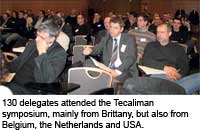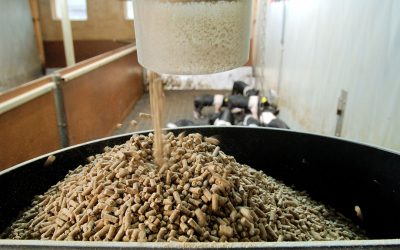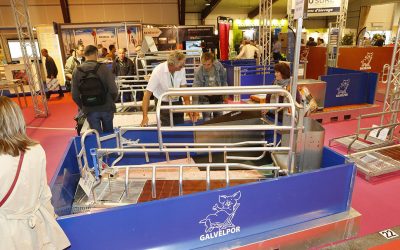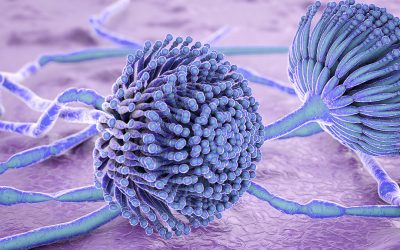Tecaliman symposium 2010: On the cross-contamination trail

With 130 delegates, the recently held Tecaliman symposium in Nantes, France, focused on cross-contaminations in feed with the next revision in 2011 of the European directive 2009/08/EC in mind.
By Philippe Caldier
“This symposium is one of the rare opportunities that we have to gather feed technologists and to talk about actual topics,” said Louis Ravé, Tecaliman’s chairman. In his welcoming words he also reminded the delegates that the association will be 30 years old next year. “We have anticipated the new European programme Benefeed [Quality and safety aspects of feed] focusing on microbiological and chemical contaminations of feed,” Ravé added. On the other hand, in April Tecaliman received a “pilot to better understand the particles flow,” a so-called Poussalim programme co-financed by the Pays de Loire region since March 2009. “Our plants have improved since 2000 and the new 2009/08/EC directive will increase their production costs,” Ravé commented further. Session chairman Miss Fayolle from Oniris (School for veterinary, agro feed and food, Nantes Atlantique) added: “The target of this symposium is to understand cross-contaminations to be able then to measure them.”
Respoul project
In his speech on ‘Coccidiostats: advantages and disadvantages’, Dr Ph Delahaut from CER Groupe (Belgium) told the audience that carry-over of coccidiostats in feed in unavoidable. With production of different feed types in the same production line it is unavoidable to transfer coccidiostats from one feed batch to another, and contamination during production, processing, storage and transport of feed. Delahaut explained that a new European Commission directive (2009/08/EC) authorises a maximum cross-contamination level of 1% and 3% depending on whether it is found in the target species or not. The previous directive provided for thresholds of 2.5% and 10% respectively.
Tightening of requirements poses, on the one hand, problems for feed producers, in particular for plants in which feed is produced for several different animal species. On the other hand it requires developing high performance and reliable test methods. “Mass spectrometry combined with liquid chromatography is currently the method of choice,” Delahaut said, who takes part in the Respoul research project in collaboration with ILVO (Research Institute in agriculture, Gent). “The target of this Respoul project is to try to create a model which would make it possible to forecast contamination levels found in eggs and meat,” Delahaut explained. The initial results presented during the talk indicate significant differences depending on the molecule. “Coccidiostats are highly useful substances for managing a disease as serious as coccidiosis, but their use must be effectively measured and managed,” he concluded.
Evaluation of the chemical risk of food
In the next presentation, Jean-Dominique Puyt – professor of pharmacy and toxicology at Oniris – brought a methodological approach for the evaluation of the chemical risk of food. “In the case of veterinary medicinal products, consumer safety is ensured by compulsory evaluation of veterinary medicinal product residues as part of the pharmacotoxicological dossier in marketing authorisation applications. The safety factors retained ensured absolute safety, even where maximum residue limits (MRL) are exceeded,” Puyt said. “No veterinary medicinal product indicated for use in production animals can be administered if the MRLs have not first been defined. Residue risk assessment involves establishment of a withdrawal time, which must be observed by farmers and for which farmers and prescribing parties are responsible
”In the case of accidental exposure to phytosanitary products or environmental contaminants or when using medicinal products outside marketing authorisation (MA) recommendations, a chemical risk assessment must be carried out on a case per case basis. This involves identification of the risk followed by establishment of an acceptable daily intake (ADI) and observance of MRLs, or, in the absence of this data, by establishment of theoretical maximum residue limits. By comparing exposure levels, the chemical risk can then be evaluated and a risk management plan established
The French FARAD centre (Food Animal Residue Avoidance Databank, a universitary network which was started in the USA at the beginning of the 80s) provides valuable assistance in chemical risk assessment in the veterinary profession, for animal production professionals, for agri-food industrialists and for State services (Veterinary Services Directorate).
Improvements in homogeneity and cross-contamination
Fabrice Putier from Tecaliman focused his speech on the updating of the database on the homogeneity and crosscontamination levels in France. “These results were presented previously at the 2008 symposium. This update concerns the 1999 withdrawal, of which the results were not as representative, with the inclusion of the results for 2006 – 2008. The panel of factories in this database is highly representative of French production, with over 80% of tonnage manufactured by 150 industrial sites in 2008.”
Putier explained that in terms of tracers used for carrying out the tests, the RF-blue lake micro tracer is now very widely used. In terms of cross-contamination, it makes it possible to produce, in most cases, assessments identical to those obtained using internal tracers.
As for homogeneity, 1,579 coefficients of variation were processed. The median over the nine years is around 4.6% and 3.9% for 2008. On average, since 2000, the median has decreased by 0.2% per year and in 2008, 90% of the tests saw results lower than 10%. All of these figures show the significant progression in terms of homogeneity. “As stated two years ago, it will be more difficult to make such progress in the future,” Putier said.
In terms of cross-contamination, the improvement in the results was very significant up to 2003. As of this year, improvement continued but at a lower rate. In 2008, 82% of the results from the first manifold batch were lower than 5% (target in the best practice guide). Directive 08/09 adds a new challenge: Targets of 1% or 3% according to the use of food. In 2008, 60% of the results were lower than 3% and only 17% were lower than 1% for the first manifold batch. 62% are lower than 1% for the second manifold batch. “Progress therefore needs to be made on processes and on active ingredients in order to reduce cross-contamination. Eliminating it however is illusory,” Putier concluded.
Cross-contamination in the delivery trucks
In a second talk, Fabrice Putier presented for the first time results regarding cross-contaminations in the delivery trucks. “The data presented here was generated during tests carried out in 2002. However, it was not published and is today of renewed importance in the light of the new directive, which implies that delivery is a potential source of cross-contamination,” he said. “The main difficulty in evaluating cross-contamination in delivery trucks lies in the many types of trucks used. In France, the large majority of them transfer feed mechanically from their bins into the farmer’s silos.”
Delivery and loading practices may lead to two types of contamination: Inter-bin contamination between successive deliveries in the same round or intra-bin contamination between successive changes in the same bin during consecutive rounds. The results were produced under worst-case test conditions: Meal, longest circuit, other bins empty. The measurements were taken on nine trucks using two types of tracers. The outcome shows that the two types of tracers achieve very similar results, that cross-contamination is very low, that intra-bin cross-contamination is minimal and finally, that the results vary according to the type of truck. They are more positive for shorter and more modern trucks and less positive for longer, older trucks. In all cases, contamination generated by the delivery trucks is of little significance, and more easily manageable with regard to that existing in feed plants. The importance of respecting the transfer system cleaning procedure following delivery of a high risk batch was highlighted.
“The contamination profiles clearly indicate that contamination takes place within the first ten kilos delivered. This is unlike in factories, where contamination involves both mass and dust transfer of a very low quantity from a product of unknown concentrations out of the whole manifold batch. Caused by trucks it involves mass, elusive transfer of a low quantity of feed of a known concentration at the start of the manifold batch,” Putier argued.
Source: AllAboutFeed vol 1 no 3, 2010











